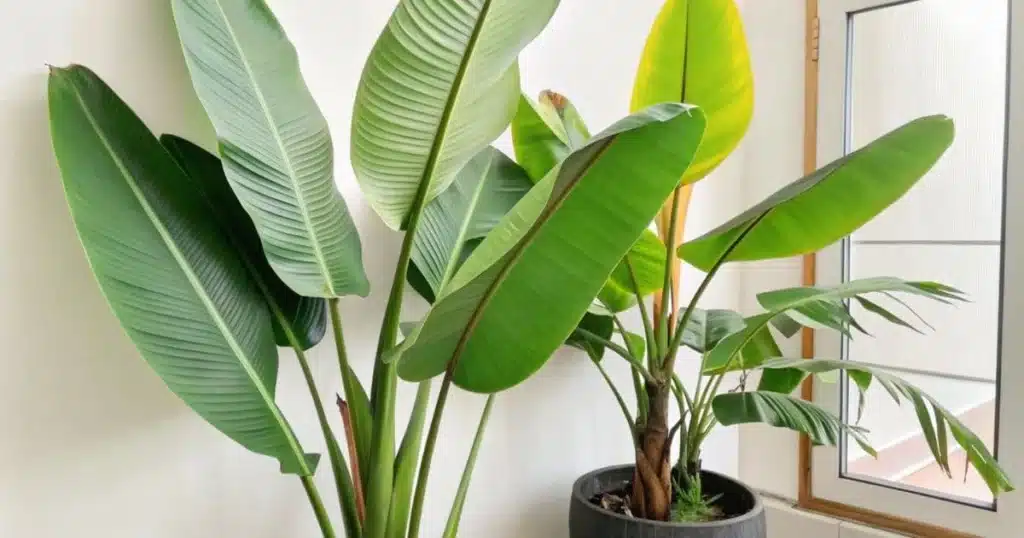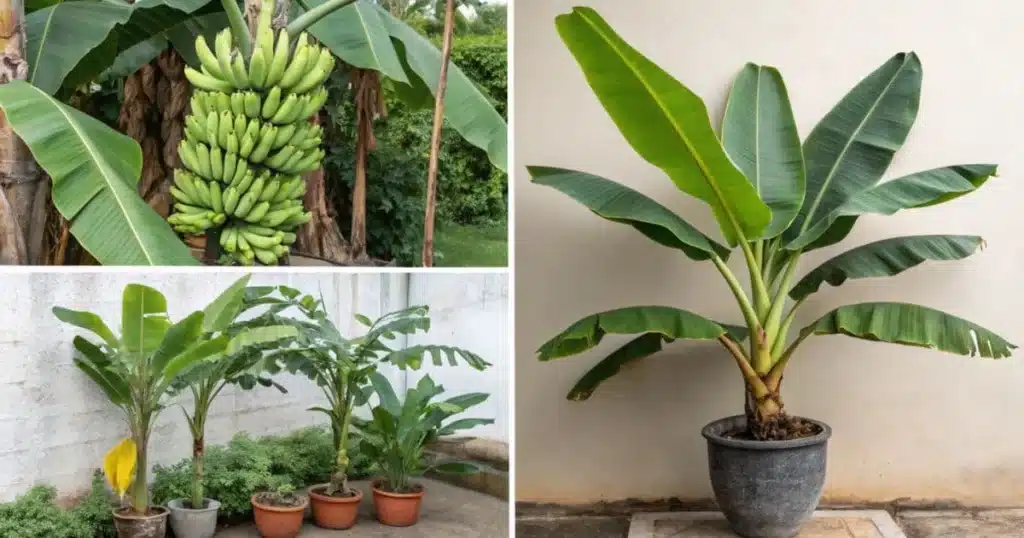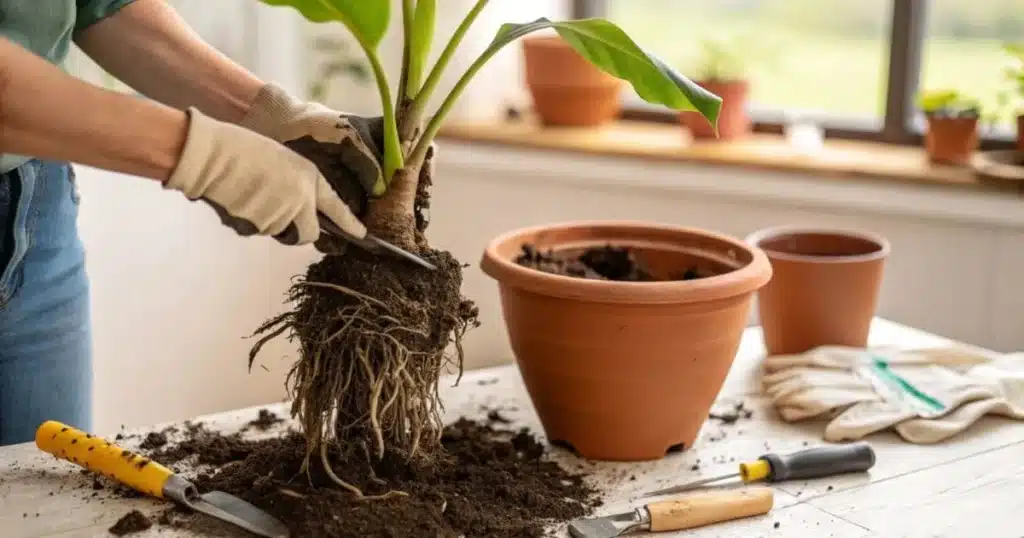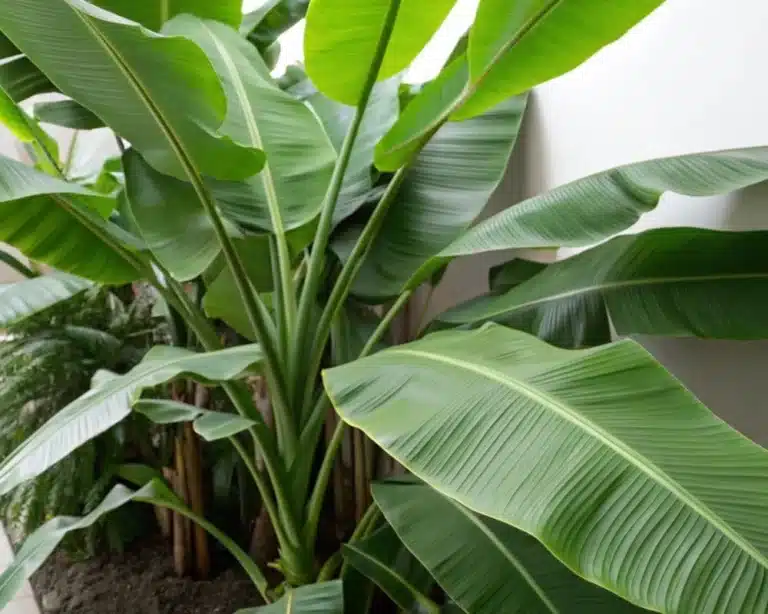Banana leaf plants are a fantastic way to bring a bit of the tropics into your home. These plants, known for their large, lush leaves, can make any space feel like a mini jungle. They’re not just pretty to look at; they also require some specific care to keep them thriving. From getting the light just right to making sure they have enough water, there’s a bit to learn if you want your banana leaf plant to be the best it can be. But don’t worry, with a little know-how and some regular attention, you can keep your plant healthy and vibrant.
Table of Contents
Understanding the Banana Leaf Plant

Characteristics of Banana Leaf Plants
Banana leaf plants, often mistaken for trees, are actually herbaceous perennials. Unlike true trees, they don’t develop woody stems. Instead, they grow large, paddle-shaped leaves from upright stalks. These lush green leaves cluster tightly around the stem, creating an impressive visual display. Typically found in tropical regions, banana leaf plants thrive in warm, humid conditions, making them a popular choice for adding a tropical touch to homes.
Common Varieties and Species
There are many species of banana trees, each with unique characteristics. Some of the most popular include the Cavendish banana, known for its edible fruit, and the Basjoo banana, which is often grown as an ornamental plant. Indoor growers may want to opt for Musa banana trees for their low maintenance, while gardeners in warmer climates may want to plant Basjoo live banana trees for their hardiness. When choosing a variety, consider whether you want a fruit plant or one that is primarily intended for decoration.

Ideal Growing Conditions
Banana leaf plants require specific conditions to flourish. They prefer full sun exposure and rich, well-drained soil with a pH between 5.5 and 7.0. These plants are best suited for USDA Hardiness Zones 8 to 10. If you’re growing them indoors, ensure they receive ample sunlight, possibly near a south-facing window. Regular watering is essential, but be cautious of overwatering as it can lead to root rot. Maintaining consistent humidity levels will also help keep the banana plant healthy and vibrant.
Watering and Soil Requirements
How to Water Your Banana Leaf Plant
Banana leaf plants are thirsty creatures, needing ample water to thrive. Ensuring that your plant receives the right amount of water is crucial. When watering, aim to keep the soil consistently moist but not soggy. Use pots with drainage holes to prevent excess water from accumulating, which can lead to root rot. Water your plant thoroughly until you see water spillage from the bottom of the pot, indicating that the soil is sufficiently moist.
- Check soil moisture regularly.
- Water when the top inch of soil feels dry.
- Avoid letting the plant sit in a saucer of water.
Selecting the Best Soil Type
For banana leaf plants, choosing the right soil is vital. Opt for a well-draining potting soil that retains moisture yet allows excess water to escape. This balance helps prevent the roots from becoming waterlogged, reducing the risk of disease. You can enhance soil drainage by mixing in materials like perlite or sand.
Preventing Root Rot
Root rot is a common issue that can be avoided with proper care. Ensure that your plant’s pot has sufficient drainage and avoid overwatering. If you notice yellowing leaves or a foul odor from the soil, it might be a sign of root rot. In such cases, reduce watering and allow the soil to dry out more between waterings. Regularly checking for these signs can help keep your banana leaf plant healthy and thriving.
“Maintaining the right balance of moisture is key to preventing root issues and ensuring the vibrant health of your banana leaf plant.”
Temperature and Humidity Control
Maintaining Ideal Temperature
Banana leaf plants thrive in warm environments. The ideal temperature range for these plants is between 75°F and 95°F. During the warmest months, ensure they are in a place where the temperature doesn’t drop below this range. In the winter months, it’s crucial to keep them away from cold drafts and maintain a minimum of 60°F to prevent damage. Night temperatures should also be monitored, as they can drop significantly. If you’re moving your plant outdoors during summer, ensure night temperatures stay above 60°F to keep your plant happy.
Increasing Humidity Levels
These tropical beauties love humid conditions, ideally between 60% and 90%. If your home has low humidity, especially during the winter months, consider using a humidity tray or a humidifier to maintain adequate humidity levels. Spider mites are more likely to attack in dry conditions, so keeping the air moist can help prevent these pests. Misting the leaves can also increase levels of humidity indoors, but ensure the leaves dry before nightfall to avoid fungal issues.
Protecting from Temperature Extremes
Banana leaf plants are sensitive to temperature extremes. Avoid placing them near windows where they might be exposed to cold temperatures or direct heat sources like radiators. If the average home temperatures are too low, consider relocating the plant to a warmer climate within your home. Consistent annual temperatures will ensure your plant remains healthy and vibrant.
Fertilizing and Nutrient Needs
Choosing the Right Fertilizer
Selecting the appropriate fertilizer is crucial for the vibrant growth of your banana leaf plant. A balanced fertilizer, such as a 6-2-12 formula, is ideal for these plants. This ratio ensures that the plant receives a higher amount of potassium, which supports strong leaf development and enhances the plant’s overall vigor. When growing banana leaf plants indoors, a houseplant fertilizer can be beneficial, particularly one that focuses on leaf color and growth.
Fertilizing Schedule and Techniques
Banana leaf plants thrive when fertilized regularly during their active growing period, which spans from spring through summer. Here’s a simple schedule to follow:
- Early Spring: Begin with a slow-release balanced fertilizer.
- Mid-Summer: Supplement with a liquid fertilizer every 4-6 weeks.
- Fall: Reduce fertilization as the plant’s growth slows.
When applying fertilizer, ensure it is evenly distributed around the base of the plant to prevent root burn. Always follow the package instructions to avoid over-fertilization.
Signs of Nutrient Deficiency
Keeping an eye on your plant’s health can help you spot nutrient deficiencies early. Look for these signs:
- Yellowing Leaves: This can indicate a lack of nitrogen or potassium.
- Stunted Growth: A possible sign of phosphorus deficiency.
- Poor Leaf Color: Might be due to insufficient magnesium or iron.
If you notice these symptoms, consider adjusting your fertilizer type or frequency to address the specific deficiency.
Pruning and Maintenance Tips
How to Prune Banana Leaf Plants
Pruning is a key part of proper care for banana leaf plants. Begin by removing any dead or dried leaves. Cut them back to where the leaf stem bends away from the plant’s “trunk.” New growth typically sprouts from the center, so be careful not to cut too close. Regular pruning helps manage plant size and encourages healthy new growth.
Cleaning and Dusting Leaves
Keeping the leaves clean is a basic care tip that promotes better photosynthesis. Dust can accumulate on leaves, blocking sunlight. Use a damp cloth to gently wipe each leaf. Avoid using any harsh chemicals; a little water will usually do the trick. Regular cleaning not only keeps your plant looking great but also boosts its health.
Managing Plant Size and Growth
Banana leaf plants can grow quite large, so managing their size is essential. If your plant is becoming too big for its space, consider repotting it into a larger container or trimming back some of the larger leaves. This not only keeps the plant to a manageable size but also encourages more robust growth. Remember, the more you prune, the more you’ll need to monitor the plant’s overall health.
Consistent care and attention to pruning will keep your banana leaf plant thriving. It’s all about balance—giving your plant enough room to grow while maintaining its shape and health.
Propagation and Repotting

Methods of Propagation
Propagating banana leaf plants is a rewarding way to multiply your collection. The most common method is by using offsets or “pups.” Here’s a quick guide:
- Gently remove the plant from its pot.
- Identify the offsets or pups, ensuring they have their own roots.
- Use clean pruning shears or a knife to separate the pup from the mother plant.
- Plant the pup in a new pot with well-draining soil.
- Place it in a warm spot with indirect light and water regularly.
Alternatively, propagation by seeds is possible, though more time-consuming. Soak banana seeds in warm water for 24 hours, then plant them in well-draining soil. Keep them warm and moist until they sprout.
When and How to Repot
Banana leaf plants are known for their rapid growth, which means they may need repotting every two to three years. Here’s how you can do it:
- Slide the plant out of its current pot.
- Loosen the roots gently, removing any that are circling or rotten.
- Choose a new pot that’s 1 to 2 inches larger in diameter.
- Fill with fresh, well-draining soil and replant.
- Water thoroughly and place in its usual spot.
Repotting is best done in spring when the plant is actively growing.
Caring for New Plants
Once your new plants are potted, they’ll need some TLC to thrive:
- Keep them in a location with bright, indirect light.
- Water them moderately, ensuring the soil remains moist but not waterlogged.
- Be cautious of root rot, especially during colder months when the plant requires less water.
- Monitor for any signs of stress or nutrient deficiency.
Repotting and propagation can breathe new life into your banana leaf plants, ensuring they continue to grow and flourish. Keep an eye out for any signs of root rot, as it can be detrimental if left unchecked.
For more tips on maintaining healthy plants, check out how to promote growth in Hostas.
Common Problems and Solutions
Identifying Pests and Diseases
Banana leaf plants are pretty resilient, but pests like aphids, spider mites, and mealybugs can still make an appearance. Keep an eye out for these tiny troublemakers. Early detection is key. A weekly check can help you spot them before they cause too much damage. If you find any, try using insecticidal soap or a little neem oil on a clean rag to wipe them off.
Troubleshooting Yellowing Leaves
Yellowing leaves can be a sign of overwatering. If you notice this, check the soil. Is it soggy? If so, ease up on the watering. Make sure your plant’s pot has good drainage and never let it sit in water. A simple fix is to place the pot on pebbles in a saucer, keeping it above any excess water.
Dealing with Overcrowding
Banana leaf plants grow quickly, and overcrowding can become an issue. If you see your plant outgrowing its pot, it might be time to repot. Plan to do this every couple of years. Choose a pot that’s slightly larger than the current one and ensure it has a drainage hole. When repotting, gently loosen the roots and remove any that are rotten or overcrowded. Fresh soil will give your plant a new lease on life.
Regular maintenance and attention to these common issues can keep your banana leaf plant thriving. Despite their care difficulty, these plants can be a rewarding addition to your indoor garden.
Conclusion
Caring for a banana leaf plant might seem like a lot, but once you get the hang of it, it’s pretty straightforward. These tropical beauties bring a lush, vibrant vibe to any space, and with the right care, they can thrive indoors or out. Just remember, they love the sun, need their soil just right, and appreciate a good drink of water without being drowned. Keep an eye on them, and they’ll reward you with their stunning foliage. Whether you’re a seasoned plant parent or just starting out, banana leaf plants are a fantastic addition to your green collection. So, roll up your sleeves and enjoy the journey of growing these magnificent plants!
Frequently Asked Questions
How much light does a banana leaf plant need?
Banana leaf plants love bright light. They need at least 6 hours of sunlight daily. If you’re growing them indoors, place them near a sunny window.
How often should I water my banana leaf plant?
Water your banana leaf plant when the top inch of soil feels dry. Make sure not to let it sit in water, as this can cause root rot.
What type of soil is best for banana leaf plants?
These plants prefer well-drained, acidic soil. You can use a tropical soil mix or make your own with perlite, coco coir, and pine bark.
How do I increase humidity for my banana leaf plant?
You can increase humidity by misting the leaves regularly or placing a tray of water with pebbles underneath the plant. As the water evaporates, it will boost the humidity.
Why are my banana leaf plant’s leaves turning yellow?
Yellow leaves can be a sign of overwatering. Make sure the soil dries out a bit between waterings to prevent this.
Can I grow a banana leaf plant outdoors?
Yes, banana leaf plants can grow outdoors in warm climates. Make sure they get plenty of sunlight and are protected from strong winds.


1 thought on “Banana Leaf Plant Care : Expert Tips for Thriving Growth”